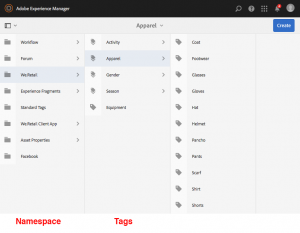Taxonomy is a categorization framework used to identify or tag content. It sets the foundation for classification using a controlled vocabulary which leads to better findability and easier information management. A taxonomy should be agreed upon by business and content owners, and flexible enough to respond to changing business needs.
Using the Taxonomy Features in AEM Assets

Let’s get nomenclature out of the way. In AEM, taxonomy is referred to as “tagging” or “tags.” And a top-level set of tags is referred to as a “namespace.” These tags can be applied as metadata on an asset or page. In AEM, you can manage tags here: /libs/cq/tagging/gui/content/tags.html/etc/tags
For help on using tags in AEM, see: https://helpx.adobe.com/experience-manager/6-3/sites/authoring/using/tags.html
For help on administering tags in AEM, see: https://helpx.adobe.com/experience-manager/6-3/sites/administering/using/tags.html
Tips for Assembling a Taxonomy
Tip #1: Taxonomies are both internal facing and external facing. To assemble a list of namespaces, think about how the organization classifies the documents or assets that will be stored in the DAM. Categories like Fund Type, Region, or Audience might be appropriate for a financial institution. Whereas for a manufacturer, Brand, Product Family, and Year are typical.
Tip #2: Facets enable the categorization of nested, independent categories, allowing the author to narrow the choices, making it easier to navigate the taxonomy tree. It’s likely the organization already has a hierarchy of products, for instance, that can be adopted as nested facets in a namespace, so be sure to look internally first, especially with the marketing department.
Tip #3: When identifying metadata, look for patterns that might be better represented as taxonomy. This also reduces the number of metadata fields and can lead to better identification of content.
More Perficient posts about taxonomy:
- Why do I need a Taxonomy? https://blogs.perficient.com/ecm/2009/08/25/why-do-i-need-a-taxonomy/
- Do Search and Tag Clouds Replace the Need for a Taxonomy? https://blogs.perficient.com/ecm/2010/03/26/do-search-and-tag-clouds-replace-the-need-for-a-taxonomy/
- Intelligent Taxonomies https://blogs.perficient.com/healthcare/blog/2012/02/20/intelligent-taxonomies/
I hope this is helpful insight into understanding the purpose and importance of a taxonomies in AEM.
